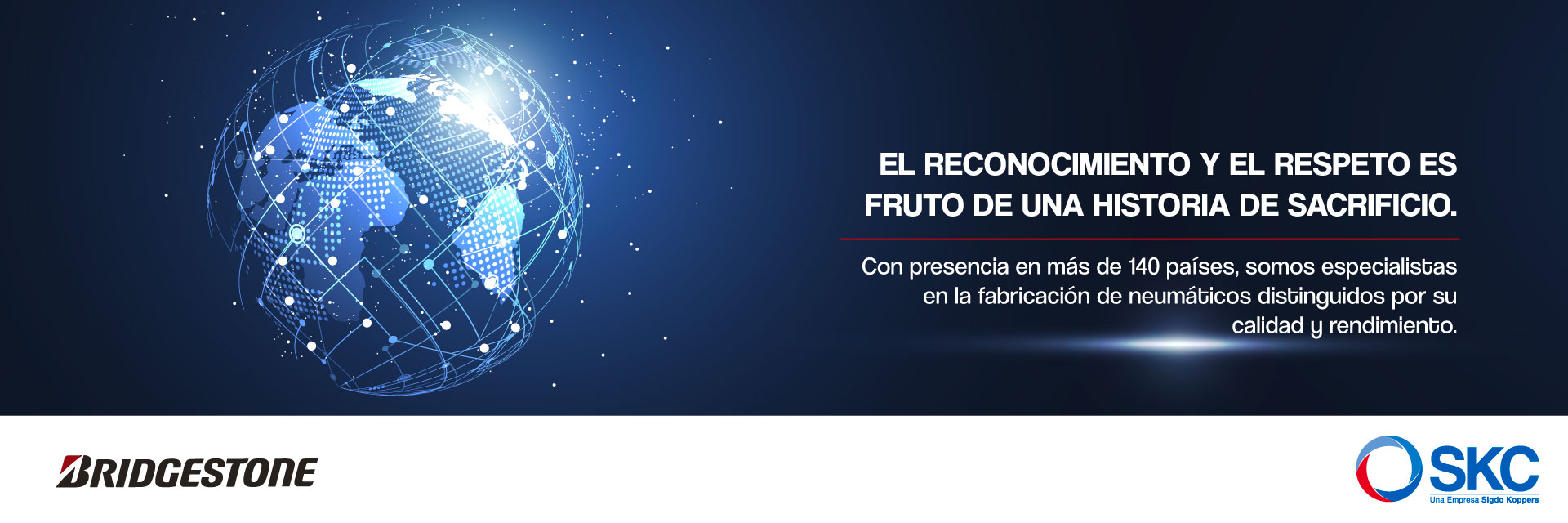Historia Bridgestone
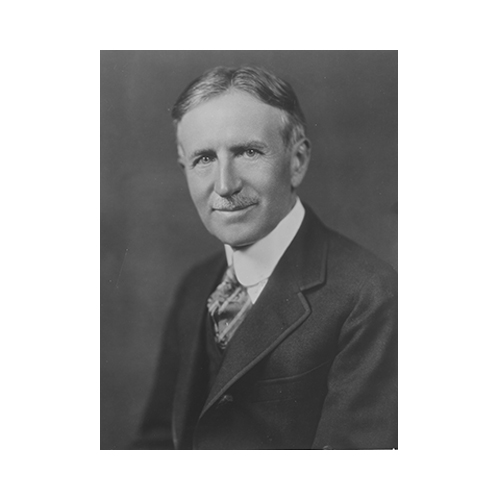
1900
FIRESTONE TIRE & RUBBER COMPANY FOUNDED
On August 3rd, 1900, the Firestone Tire & Rubber Company was founded in Akron, Ohio. In the initial days, they introduced the solid rubber sidewire tires as one of the first Firestone products. On December 27th, Harvey S. Firestone Jr. was lifted into the air to pull the engine switch that put the first Firestone factory in operation

1910
FIRESTONE OPENS AKRON, OHIO FACTORY
In 1910, profits for The Firestone Tire & Rubber Company exceeded $1 million for the first time. By June 1910, Firestone’s new factory in Akron, Ohio opened. A few years later, Ohio became the hub of the tire industry, leading manufacturing of automobile castings and rubber inner tubes. It also had more rubber workers than any other state, with 63,637 people working at various tire companies. Firestone’s line of plants, which extended for more than a mile, was linked together by more than six miles of interplant railroad and a 70-ton locomotive. The company now had its own rail line to move raw materials and finished products.
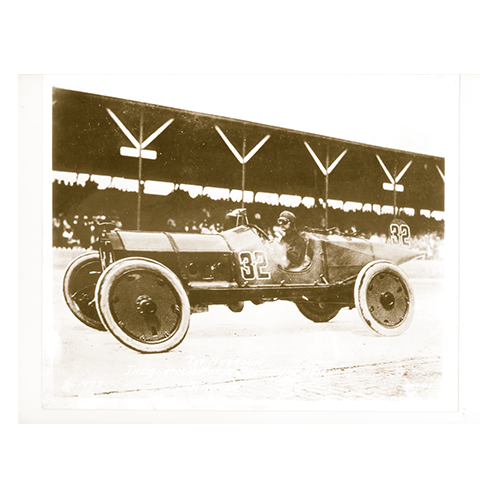
1911
FIRESTONE RACING WIN
On May 30, 1911, Ray Harroun drove his Firestone-equipped Marmon Wasp to victory at the inaugural Indianapolis 500® mile race.
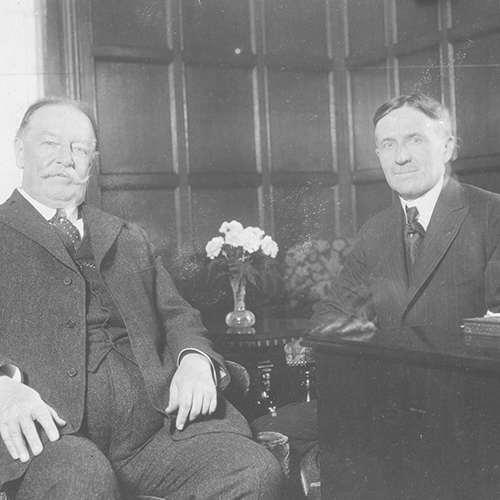
1920
WILLIAM HOWARD TAFT VISITS AKRON
Ex-President William Howard Taft arrived in Akron and visited with Harvey S. Firestone. It was one of the first indicators that Firestone was becoming an important figure in national affairs.

1922
BALLOON TIRE PRODUCTION BEGINS
Factory production of the industry’s first low-pressure balloon tire began on April 5, 1922. This breakthrough was made possible by incorporating the gum-dipping process invented in early 1920, a method of insulating tire cords against internal heat. Balloon tires offered the average motorist extraordinary mileage for the time.
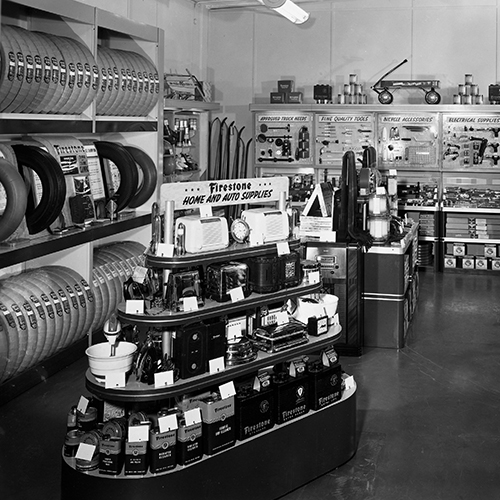
1923
FIRESTONE TIRE & SERVICE CENTER
Firestone began initiating the one-stop service store program, eventually called the Firestone Tire & Service Center.
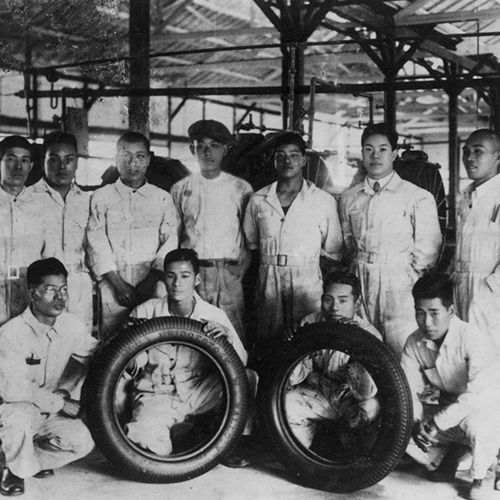
1930
CREATION OF THE BRIDGESTONE COMPANY AND PRODUCTION OF THE FIRST TIRE
Using the capital accumulated from Jika-tabi and the rubber shoe business, Shojiro Ishibashi decided to make tires, which was an industry that didn't exist in Japan at that time.

1935
FIRESTONE “PUT THE FARM ON RUBBER” CAMPAIGN
In the 1930s, the Depression hit the automobile industry and along with it, the tire business. Firestone sales began a five-year decline. To expand its market, Firestone developed the first practical low-pressure pneumatic tractor tire and began the “Put the Farm on Rubber” campaign. Just a few years later, Firestone’s sales enjoyed a remarkable turnaround. Sales, which began to decline in 1930, ended up at $121 million in 1935.
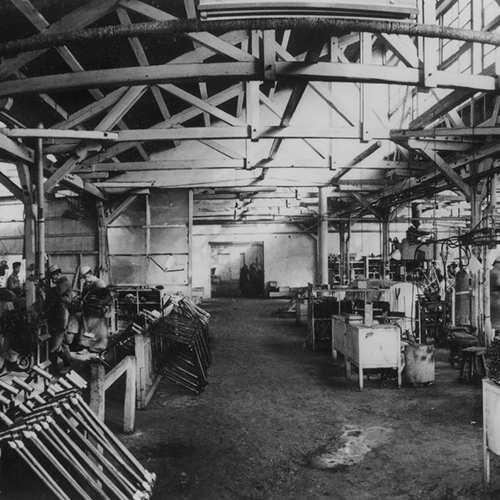
1940
CHALLENGES BROUGHT ON BY WORLD WAR II
Wartime regulations were in effect throughout Japan, which resulted in nearly all of Bridgestone’s output being used to satisfy military demand. Although 1945 saw the end of armed conflict, the company had been directly impacted by the war and faced challenges in rebuilding their business operations. The Bridgestone Tokyo Headquarters building was destroyed during an aerial bombing raid, and all of its overseas assets were lost. Fortunately, the plants in Kurume and Yokohama escaped unscathed, and the company was able to restart production immediately after the war ended. The company overcame many obstacles and eventually emerged from the war as a stronger organization.
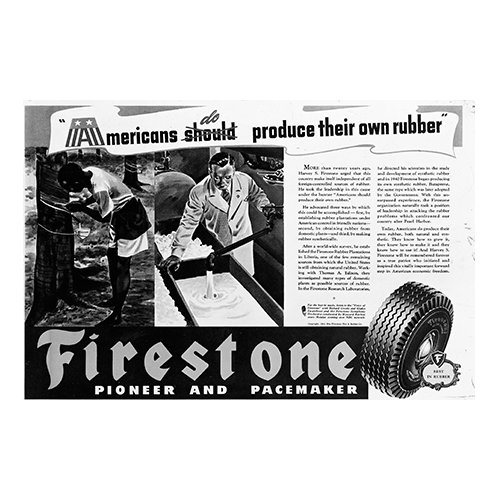
1942
FIRESTONE STARTS PRODUCING SYNTHETIC RUBBER
As war loomed in Europe and Asia, the possibility that natural rubber shipments from Africa and Asia would be cut off grew rapidly. To fill the need for a natural rubber substitute, Firestone started producing synthetic rubber. The company developed and began manufacturing special tires for combat vehicles and other military items, and by 1942, Firestone became the first to produce synthetic rubber in a government-owned plant. As the company turned 45, the company had made extraordinary contributions to the war effort, including synthetic rubber and a variety of products that could also be used in post-war times.
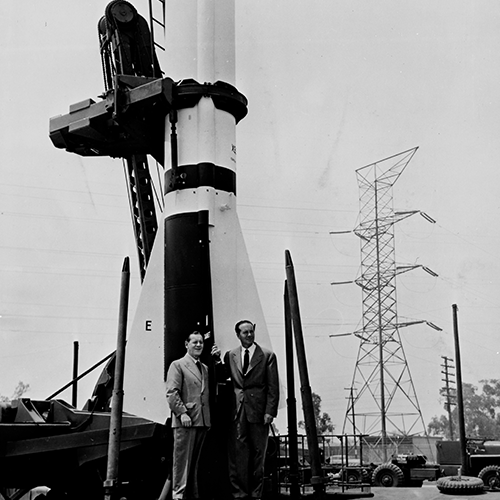
1950
FIRESTONE CONTRIBUTES TO WAR EFFORTS
At the time of Firestone’s 50th anniversary, the war in Korea was underway and Firestone was very much a part of the war effort. In Fall River, Massachusetts, The Firestone Rubber & Tire Company made gas masks, and in Akron, Plant 3 was devoted to defense products—it was expanded to the point that Firestone was ranked as one of the principal producers of 57mm and 75mm recoilless rifles for ground forces. At the Los Angeles plant, Firestone began producing the Corporal guided missile for the government, and by 1953 Firestone’s defense business was at its peak with $1,029,492,035 in sales.

1951
BRIDGESTONE TECHNOLOGICAL INNOVATION AND MASS PRODUCTION
Bridgestone was the first company in Japan to begin selling rayon cord tires, and a five-year project to modernize production facilities was started. This year also saw another Bridgestone building opened in Kyobashi, Tokyo, which contained the Bridgestone Museum.
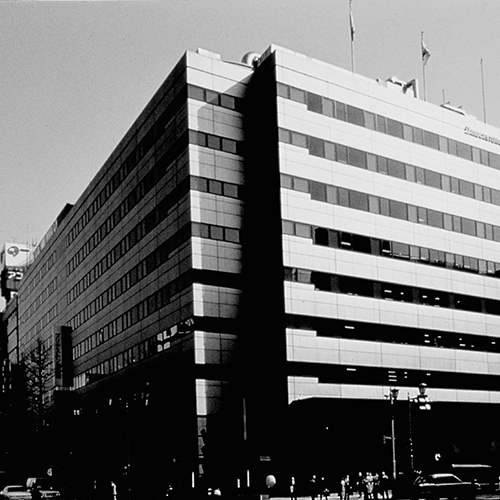
1953
BRIDGESTONE SALES SURPASS 10 BILLION YEN
Sales surpassed 10 billion yen in 1953, placing Bridgestone at the top of tire industry in Japan, and celebrations were held to commemorate the 25th anniversary of the company's establishment in Kurume in 1956.
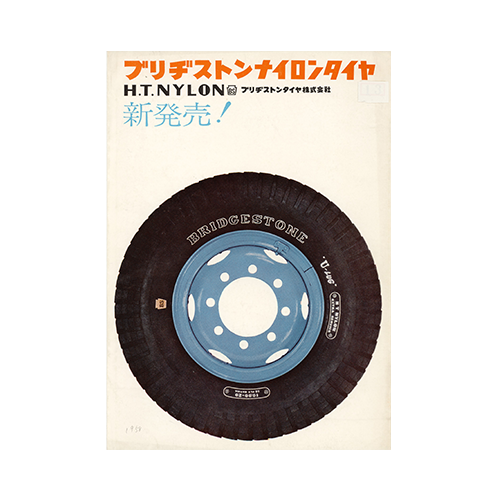
1959
BRIDGESTONE BEGINS SELLING NYLON TIRES

1960
BRIDGESTONE OPENS NEW PLANT IN TOKYO
To better meet the needs of an expanding automotive market, a new plant opened in Tokyo in 1960. Additions were built onto the Tokyo plant in 1962 to house the new Technical Center, and a progressive system of research and development was established.
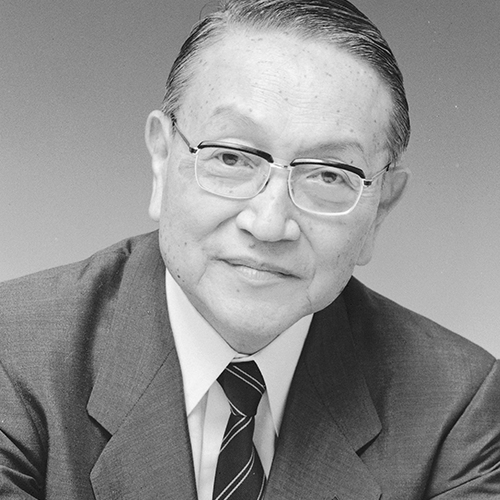
1961
BRIDGESTONE LISTED ON THE JAPANESE STOCK EXCHANGE
Bridgestone was listed on the Japanese stock exchange, and adopted a new management structure with Shojiro Ishibashi as the chairman, and Kanichiro Ishibashi as the president. As part of the management transition, the company adopted the Deming Plan, which involves overall quality control activities.
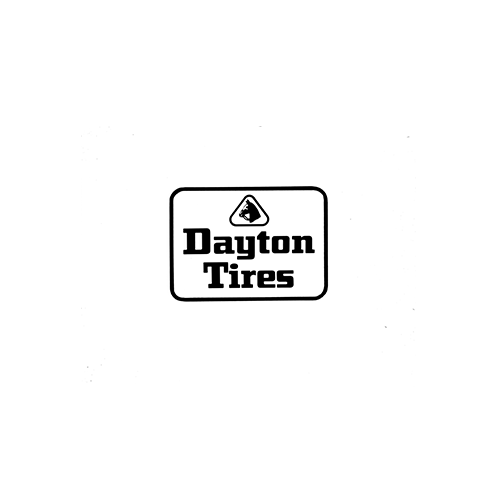
1961
FIRESTONE ACQUIRES DAYTON TIRE

1964
TIRE INNOVATIONS FROM FIRESTONE
Firestone introduced and began producing radial ply passenger tires for replacement use on lightweight American and European cars, as well as the “Super Sports Wide Oval” tire. Called the “Shape of the Future,” the tire was readily accepted by auto manufacturers as original equipment on many 1967 high-performance cars. This concept of wide, low-profile tires for high-performance cars continued throughout the century.
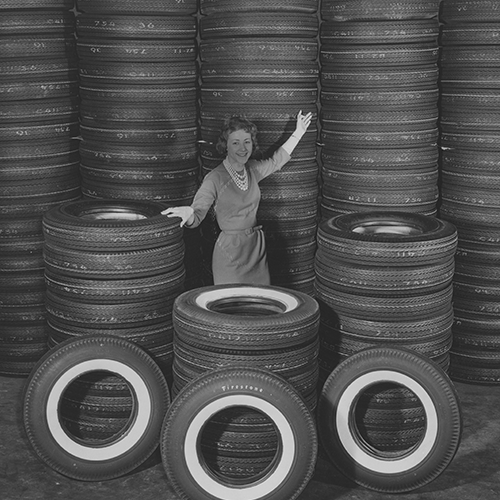
1965
FIRESTONE HITS ANNUAL SALES RECORD
Firestone celebrated its 65th anniversary with a record $1.45 billion in sales across 23 countries, the highest sales record in its history. At that point, the company made and marketed 3,600 types and sizes of tires as well as 2,000 other products in the fields of rubber, metals, plastics, synthetics, textiles and chemicals. Firestone later also became one of the nation’s major seatbelt suppliers.

1965
BRIDGESTONE OPENS PLANT IN SINGAPORE
The company opened its first overseas plant since the end of WWII in Singapore.
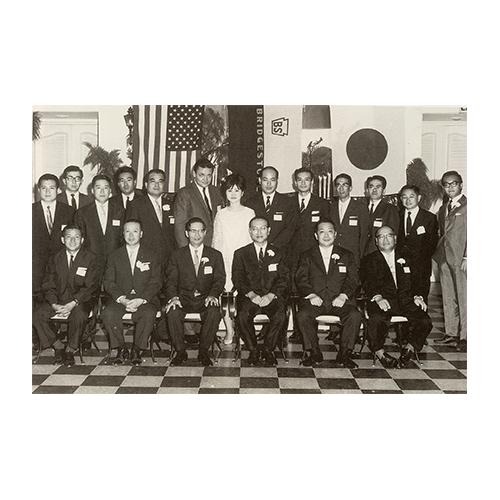
1967
Bridgestone Tire Company of America Established
For Bridgestone, the 60s was an era of overseas expansion that included the establishment of Bridgestone Tire Company of America in 1967 to serve as the company's U.S. sales headquarters. On the product front, 1967 saw the sale of its first passenger-vehicle radial tire, the RD-10.

1968
THE BRIDGESTONE COMPANY MOTTO WAS WRITTEN BY SHOJIRO ISHIBASHI
The company opened its first overseas plant since the end of WWII in Singapore.
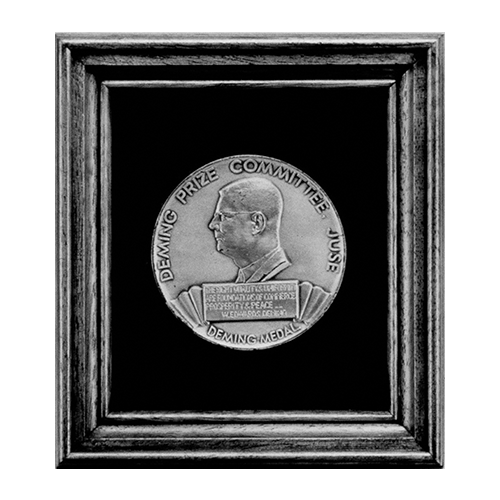
1968
BRIDGESTONE EARNS DEMING PRIZE
Bridgestone earned the prestigious Deming Prize for excellence in quality management.

1969
BRIDGESTONE BEGINS PRODUCTION IN THAILAND

1971
BRIDGESTONE BUILDS PLANTS IN JAPAN
The oil shock of the early ‘70's brought about economic stagnation in Japan. Despite these challenges, during this period Bridgestone was placing even more emphasis on establishing its own technology for the manufacture of radial tires and was building new tire plants in Japan.

1976
BRIDGESTONE EXPANDS OVERSEAS
Bridgestone actively continued to expand overseas. In addition to beginning production in Indonesia and Iran in 1976, the company invested in a Taiwanese tire manufacturer and purchased a tire plant.

1978
BRIDGESTONE INTRODUCED THE SUPER FILLER RADIAL TO THE MARKET
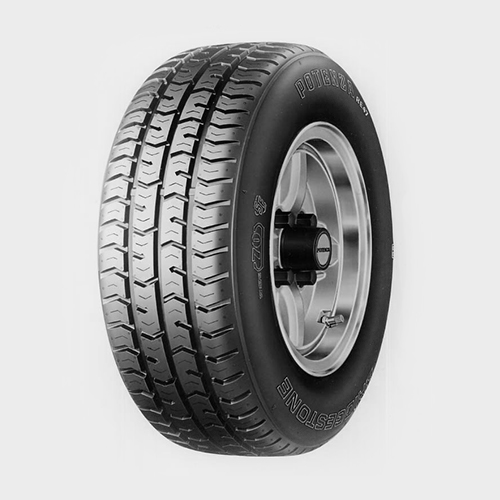
1979
BRIDGESTONE RELEASED THE HIGH-PERFORMANCE POTENZA RADIAL TIRE
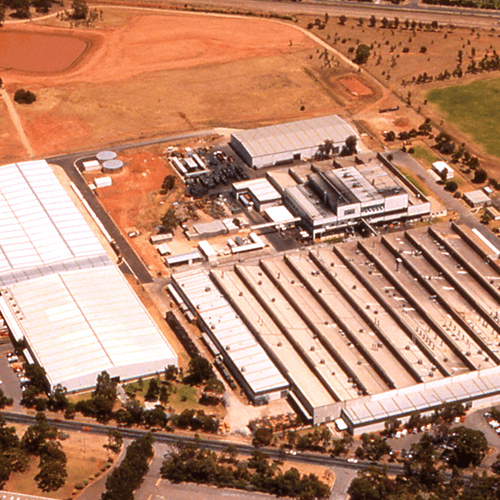
1980
BRIDGESTONE PURCHASES PLANT IN AUSTRALIA
Bridgestone purchased a plant for manufacturing tires and diversified products in Australia.
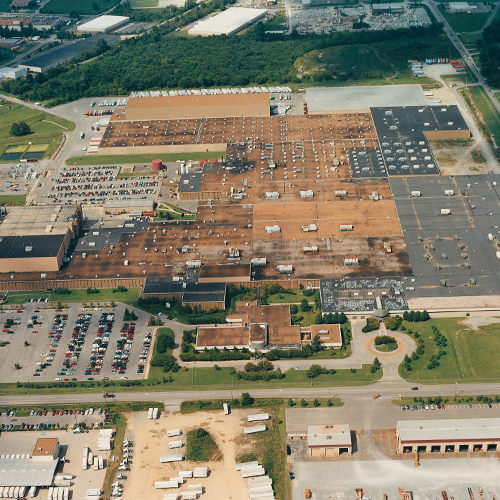
1981
BRIDGESTONE PURCHASES A TIRE PLANT IN TENNESSEE
On March 1, 1981, Bridgestone celebrated its 50th anniversary. The company set its sights on strengthening its homebase while simultaneously expanding overseas to hopefully become one of the world's top three manufacturers of rubber products. As part of this strategy Bridgestone purchased a tire plant in Tennessee from the Firestone Tire & Rubber Company, which became the company's first manufacturing plant in North America. Bridgestone began production of truck and bus radial tires at the plant in 1983.
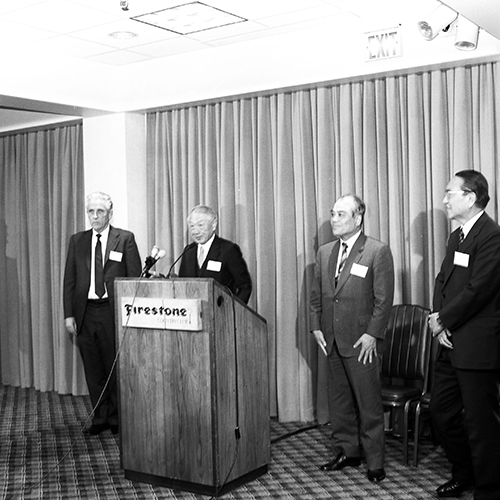
1988
BRIDGESTONE MERGES WITH THE FIRESTONE TIRE & RUBBER COMPANY
In May 1988, Bridgestone acquired The Firestone Tire & Rubber Company, which transformed Bridgestone into one of the world's largest tire and rubber companies. The acquisition of Firestone gave Bridgestone a large number of production sites in North America, Central and South America, Europe, and other locations. Bridgestone also began operations in Turkey under a joint management agreement in 1988.
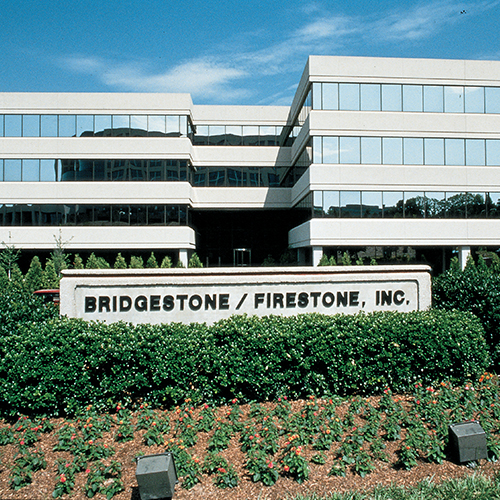
1992
NEW EUROPEAN AND AMERICAN HEADQUARTERS LOCATIONS
The company's successful integration efforts with Firestone led to strong profits in 1992 and the establishment of a new European and American headquarters location for Bridgestone.
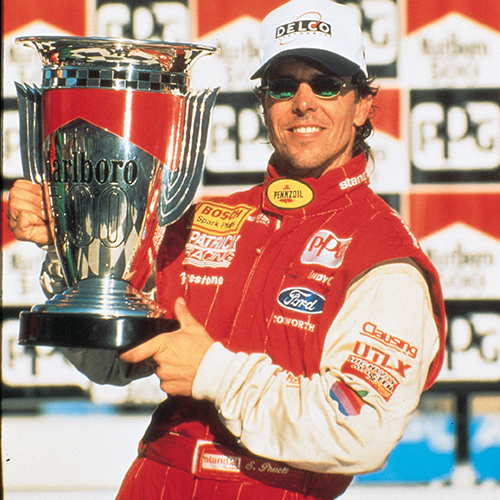
1995
BRIDGESTONE RE-ENTERS FIRESTONE INTO THE INDY 500
To enhance brand awareness and build on Firestone's legacy of excellence in motorsports, Bridgestone re-entered the Firestone brand into CART IndyCar® Series competition and Indianapolis 500 Mile Race®. As of 2015, Firestone has shod 66 Indy 500 winners – more victories than all other tire manufacturers combined.
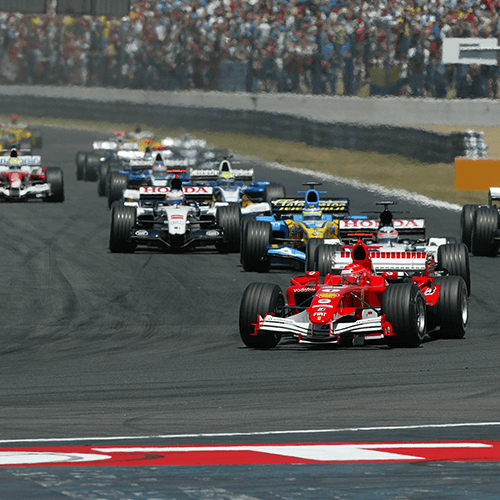
1997
BRIDGESTONE ENTERS FORMULA 1 RACING
The Bridgestone brand entered Formula 1 racing, which is the one of the most popular and technologically-advanced forms of racing worldwide.
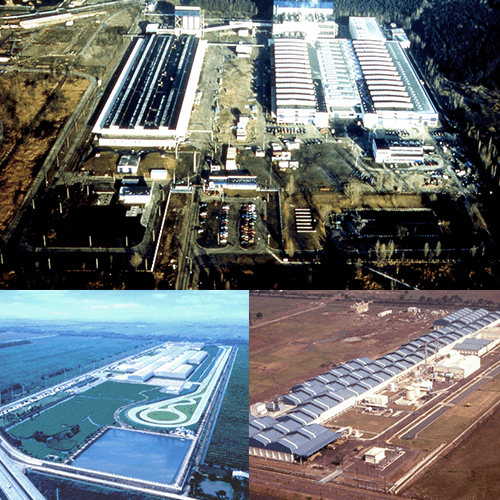
1998
GLOBAL EXPANSION
New production facilities were established in Thailand, India, Poland, China, the United States and other countries as Bridgestone continued to expand its business globally.
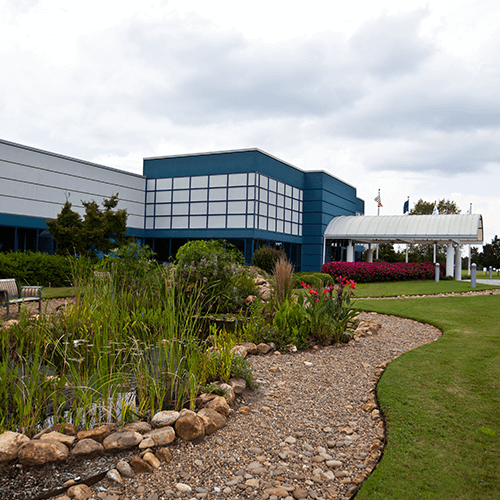
1998
BRIDGESTONE AMERICAS OPENS FIRST NEW PASSENGER TIRE PLANT IN U.S.
Bridgestone Americas began operations at its first new passenger tire facility in the U.S., located in Graniteville, S.C.

2000
BRIDGESTONE CORPORATION BUILDS CHEMICAL AND INDUSTRIAL PRODUCTS TECHNICAL CENTER
The Chemical and Industrial Products Technical Center was built inside the plant in Yokohama, Japan to serve as the technology and innovation hub for the company's growing Diversified Products business.
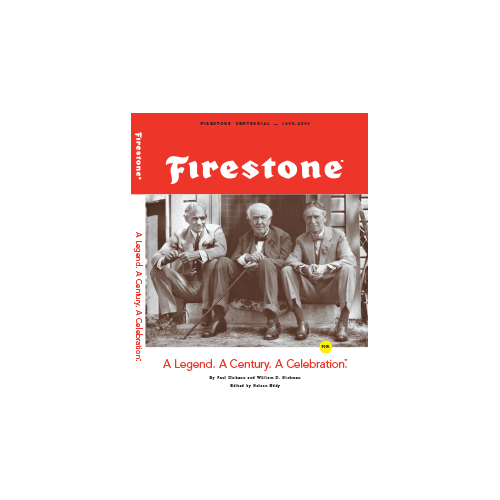
2000
FIRESTONE CENTENNIAL: A LEGEND, A CENTURY, A CELEBRATION.
Bridgestone commemorated a century of success for the iconic Firestone brand—celebrating the progress from plows to rubber and rims to present-day passenger, commercial, agricultural and race tires as well as a wide array of diversified products boasting the Firestone name.

2001
FIRESTONE BECOMES THE OFFICIAL TIRE OF THE VERIZON INDYCAR® SERIES
Firestone became the Official Tire of the Verizon IndyCar® Series and the Indianapolis 500 for the 2002 season and beyond.

2003
BRIDGESTONE AMERICAS CONSOLIDATES NASHVILLE OFFICES INTO ONE LOCATION
From 1992 until 2003, Bridgestone Americas’ corporate and tire operations worked in four office locations on the east side of Nashville, Tenn. In 2003, all offices combined into one building.
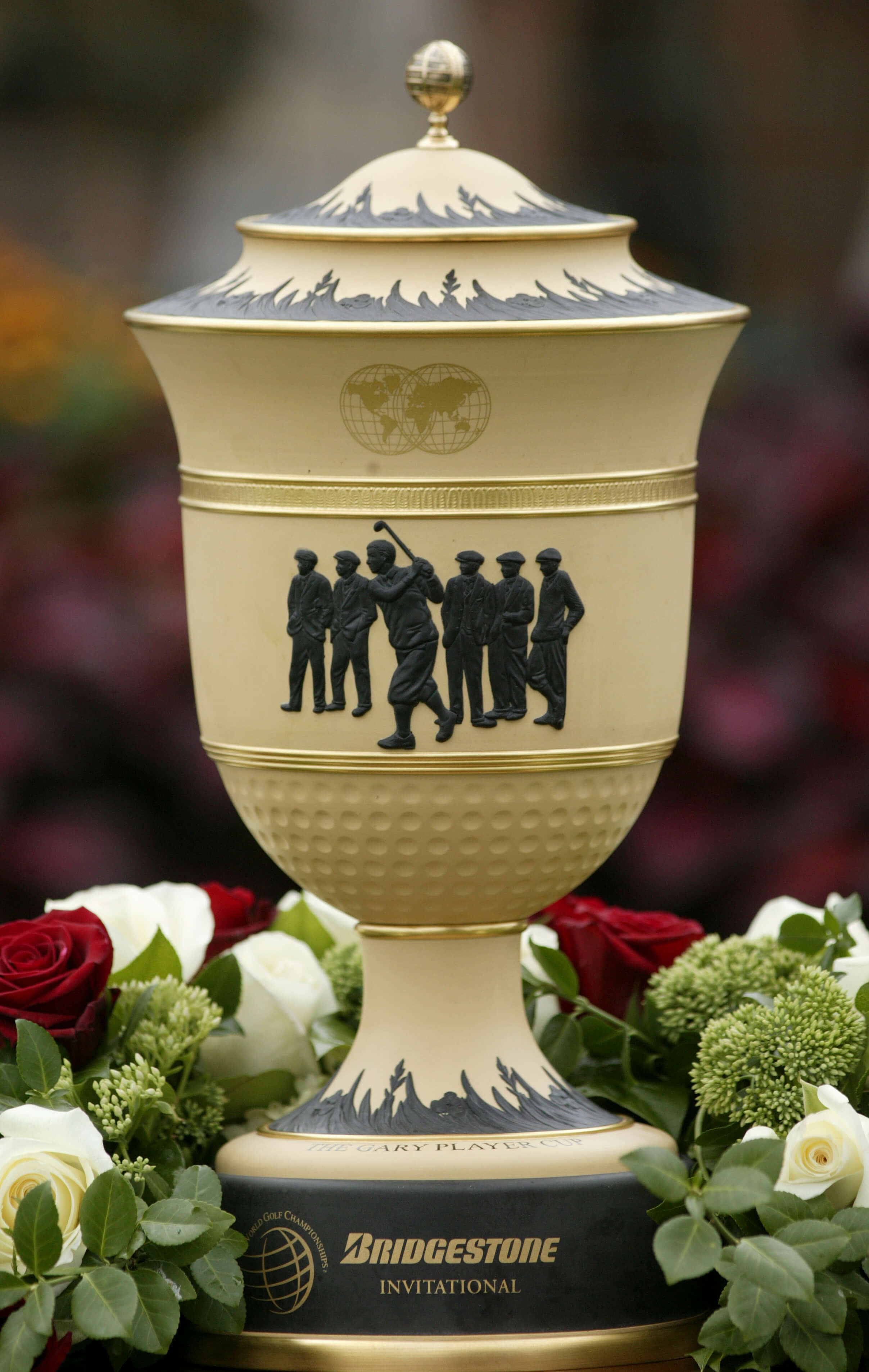
2006
BRIDGESTONE HOSTS WORLD GOLF CHAMPIONSHIPS- BRIDGESTONE INVITATIONAL
In 2006, Bridgestone first hosted the WGC – Bridgestone Invitational which is one of four World Golf Championships tournaments conducted annually by the PGA TOUR. Held at Akron, Ohio’s famed Firestone Country Club, this premier event showcases the world’s best golfers while making positive economic and charitable impacts on the NE Ohio community each year.
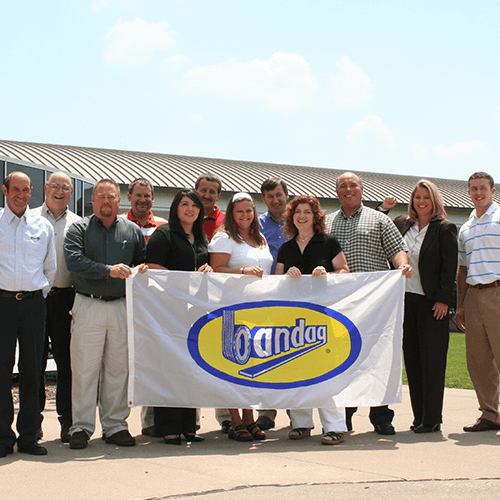
2007
BRIDGESTONE ACQUIRES BANDAG
Bridgestone Americas acquired Bandag, Incorporated, a tire retreader based in the United States. This allowed Bridgestone to provide truck and bus tire customers worldwide with leading technology and a total tire solution.

2007
BRIDGESTONE OPENS TWO NEW TIRE PRODUCTION FACILITIES IN LATIN AMERICA
In 2007, Bridgestone opened two new passenger and light truck tire production facilities in Latin America. An 18-acre plant was constructed on 247 acres in Bahia, Brazil. This, paired with the 430,500 square-foot plant that opened in Monterrey, Mexico, marked the 47th tire plant of the global Bridgestone Group.

2010
BRIDGESTONE ARENA NAMING-RIGHTS AND MARKETING PARTNERSHIP
Bridgestone entered into a multi-year naming-rights and marketing partnership with the Nashville Predators® of the National Hockey League® and Powers Management for the arena in downtown Nashville. It is known as Bridgestone Arena.

2011
80TH ANNIVERSARY OF BRIDGESTONE FOUNDING, RELEASE OF BRIDGESTONE ESSENCE
Bridgestone Corporation unveiled a new Bridgestone symbol and a new brand tagline and announced a refinement of its corporate philosophy, “The Bridgestone Essence”, to mark the 80th anniversary of the Bridgestone Group’s founding. This enhancement of the Bridgestone symbol and tagline is part of an integrated strategy to further strengthen the Bridgestone brand globally.

2013
25TH ANNIVERSARY OF THE BRIDGESTONE-FIRESTONE MERGER
Bridgestone celebrates the 25th anniversary of merging with Firestone Tire & Rubber Company, establishing itself as the world’s largest tire and rubber company.
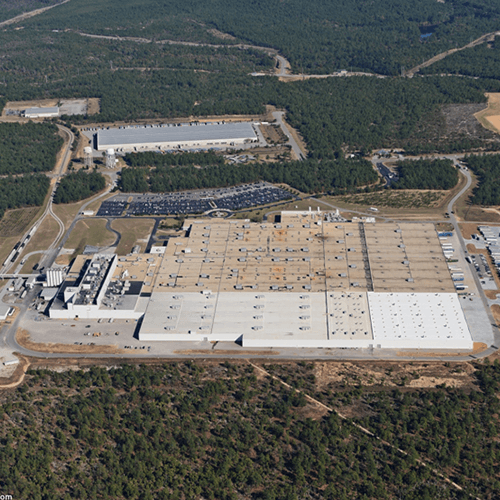
2013
BRIDGESTONE AMERICAS EXPANDS ITS AIKEN, S.C. PASSENGER TIRE PLANT
Bridgestone completed a two-phase expansion at its passenger and light truck tire operations in Aiken County, S.C., increasing the plant’s footprint to 2.4 million square feet and resulting in a rated production capacity of 13.4 million tires annually.
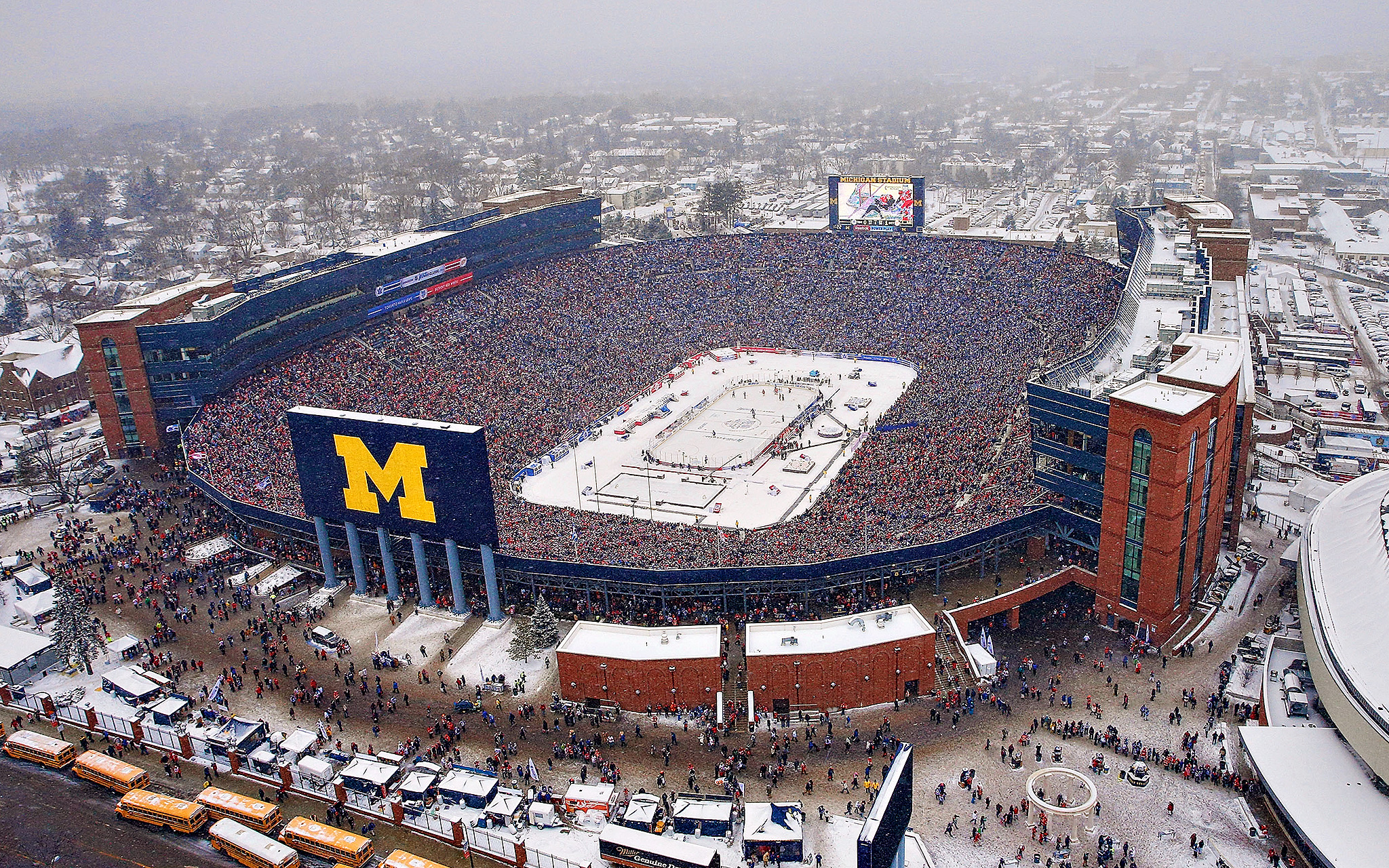
2014
BRIDGESTONE WINTER CLASSIC REACHES RECORD-BREAKING VIEWERSHIP
The Bridgestone NHL Winter Classic reached a record-breaking 8.2 million North American viewers; the largest national audience in the U.S. and Canada, and it hosted 105,491 fans at the game – the largest crowd ever to see an NHL hockey game at one time. It was named the Sports Business Journal’s 2014 Sports Event of the Year.
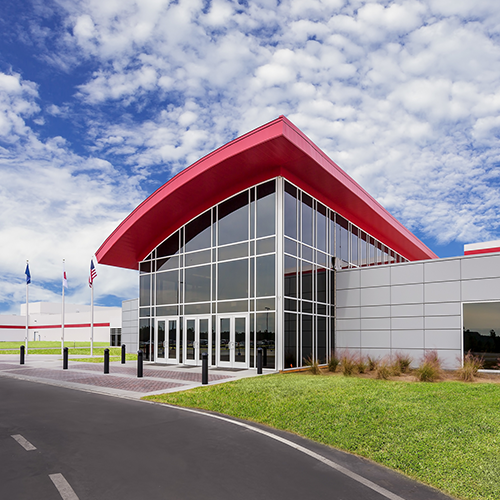
2014
BRIDGESTONE AMERICAS OPENS FIRST GIANT OFF ROAD RADIAL TIRE PLANT
Bridgestone Americas opened its first giant off road radial tire plant in August 2014. Based in Aiken County, S.C., the 1.5 million-square-foot manufacturing facility produces various off road radial tire products used to equip heavy haul trucks in mining and aggregates applications.
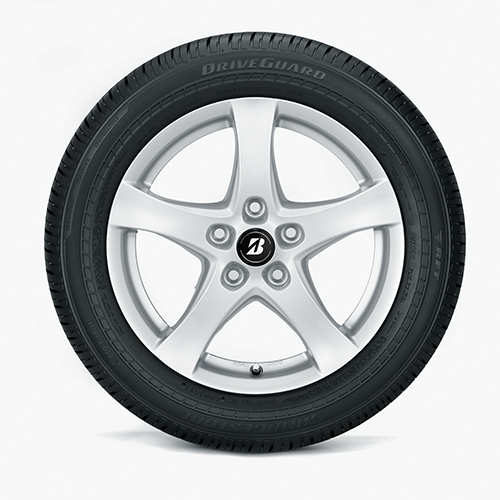
2014
DRIVEGUARD RUN-FLAT TIRE RELEASED
In 2014, Bridgestone revolutionized the tire industry with the launch of its DriveGuard tire line. Bridgestone DriveGuard is the first full run-flat replacement tire line available for coupes, sedans and wagons not originally equipped with run-flat technology.

2015
FROM SEED TO TREAD: BRIDGESTONE REVEALS FIRST TIRES MADE OF NATURAL RUBBER COMPONENTS FROM COMPANY’S GUAYULE RESEARCH OPERATIONS
Bridgestone Corporation announced in October 2015 that it successfully built passenger tires with 100 percent of its natural rubber-containing components derived from guayule, a desert shrub that grows in arid regions.
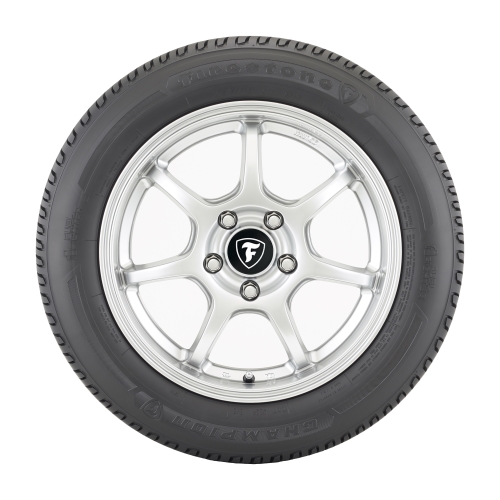
2016
BRIDGESTONE REINTRODUCES CHAMPION NAME TO FIRESTONE TIRE LINE
Bridgestone launched the all-new Firestone Champion tire with Fuel-Fighter Technology in 2016. The Champion name was first used by Firestone for passenger tires in the 1930s and celebrates a legacy of trusted performance. The new Firestone Champion tire was designed to deliver dependable, all season performance for cars and minivans.

2016
FIRESTONE CELEBRATES THE 100TH RUNNING OF THE INDIANAPOLIS 500
On May 29, 2016, the motorsports world celebrated the 100th Running of the Indianapolis 500 Mile Race. Rookie driver Alexander Rossi crossed the legendary yard of bricks first, becoming the 67th Firestone-shod Indy 500 winner – more Indy 500 victories than all other tire manufacturers combined.













